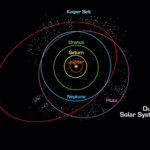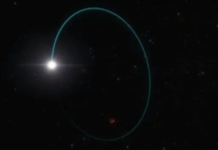
London– Raising the hope to find alien life near us, an international team of astrophysicists has discovered three Earth-sized planets orbiting near the “habitable zone” of a dwarf star — the first planets ever discovered around such a tiny and dim star.
The planets are so close to Earth — only 40 light years away — that astronomers should eventually be able to study in greater detail the composition of each of the planets and their atmospheres as well as look for chemical signals of life.
“The kind of planets we’ve found are very exciting from the perspective of searching for life in the universe beyond Earth,” said Adam Burgasser, professor of physics at the University of California-San Diego’s centre for astrophysics and space sciences.
Using a telescope at the La Silla Observatory is Chile, the astronomers traced the star’s light moment-to-moment over the course of 62 nights in September through December last year.
When the team led by Michael Gillon of University of Liege, Belgium, analysed changes in brightness of the starlight, they saw periodic dips as three planets traverse its face casting shadows.
Follow-up observations with larger telescopes indicated that the planets have sizes very similar to that of the Earth.
Two of the planets have orbital periods of about 1.5 days and 2.4 days respectively, and the third planet has a less well determined period in the range 4.5 to 73 days.
“With such short orbital periods, the planets are between 20 and 100 times closer to their star than the Earth to the Sun,” said Gillon.
“The structure of this planetary system is much more similar in scale to the system of Jupiter’s moons than to that of the solar system,” he noted.
The team determined that the three planets are roughly Earth-sized and may be rocky, although additional measurements of their masses will be needed to determine their compositions.
More importantly, although they orbit very close to their host dwarf star, the inner two planets only receive four times and twice, respectively, the amount of radiation received by the Earth, because their star is much fainter than the Sun.
It is still possible that they possess habitable regions on their surfaces, although complexities such as their clouds and atmospheres — if they have atmospheres — make it hard to predict whether surface conditions are really suitable for life.
The third, outer, planet’s orbit is not yet well known but it probably receives less radiation than the Earth does, but maybe still enough to lie within the habitable zone.
The star the planets orbit — called “TRAPPIST-1” — is cool, red, dim and so small it is invisible to most telescopes.
Just a little larger than Jupiter in diameter, TRAPPIST-1 is about half the temperature of the Sun, a tenth of the size and almost 2,000 times fainter.
Most of what astronomers know about it comes from observations in the infrared, the same kind of invisible light that remote controllers emit.
Although astronomers who hunt for exoplanets are eager for the deployment of the James Webb Space Telescope, now slated to launch in 2018, the discovery team is already expanding observations of these planets’ orbits and their magnetic interactions with the star.
The discovery was detailed in a paper published in the journal Nature. (IANS)














